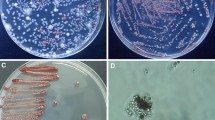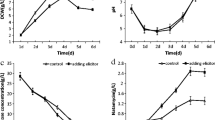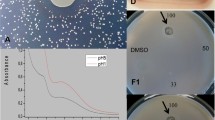Abstract
The viability and biomass production of three isolates of Kluyveromyces spp. in six different growth media were studied. All yeast isolates showed good growth in all of the media tested, but nutrient yeast dextrose broth (NYDB 75 %) and molasses soy meal (MSB) media were selected for further analyses. The adaptive response of the yeasts to heat shock and water stress was studied, revealing that 60 min of incubation at 45 °C and a water activity value of 0.95 aw were the appropriate conditions to adapt these yeasts for subsequent analyses. The physiological adaptation did not affect the ecological similarity between biocontrol agents and pathogen. The adapted yeasts also had a negative influence on the growth of Aspergillus flavus RCM89 mycelia and the accumulation of aflatoxin B1 levels in vitro. These results have important implications for optimizing the formulation process of proven biocontrol agents against A. flavus. In addition, the applications of physiological methods are necessary for increasing the performance of biocontrol agents. Moreover, the physiological methods could enhance survival under environmental stress conditions of biological control agents.

Similar content being viewed by others
References
Ang D, Liberek K, Skowyra D, Zylicz M, Georgopoulos C (1991) Biological role and regulation of the universally conserved heat shock proteins. J Biol Chem 266:24133–24236
Biryukova EN, Medentsev AG, Arinbasarova AY, Akimenko VK (2007) Adaptation of the yeast Yarrowia lipolytica to heat shock. Mikrobiologiya 76:158–163
Bonaterra A, Cabrefiga J, Camps J, Montesinos E (2007) Increasing survival and efficacy of a bacterial biocontrol agent of fire blight of rosaceous plants by means of osmoadaptation. FEMS Microbiol Ecol 61:185–195
Cañamás TP, Viñas I, Usall J, Magan N, Solsona C, Teixido N (2008) Impact of mild heat treatments on induction of thermotolerance in the biocontrol yeast Candida sake CPA-1 and viability after spray-drying. J Appl Microbiol 104:767–775
Codex Alimentarius (2012) Prevención y Reducción de la Contaminación de los Alimentos y Piensos. Primera edicción. Available at: ftp://ftp.fao.org/codex/Publications/Booklets/Contaminants/CCCF_2012_ES.pdf.
Costa E, Teixidó N, Usall J, Atarés E, Viñas I (2001) Production of the biocontrol agent Pantoea agglomerans strain CPA-2 using commercial products and by-products. Appl Microbiol Biot 56:367–371
Cotty PJ, Bayman P, Egel DS, Elias KS (1994) Agriculture, aflatoxins and Aspergillus. In: Powel KA, Renwick A, Peverdy JF (eds) The Genus Aspergillus: from taxonomy and genetics to industrial application. Plenum Press, New York, pp 1–27
Cuero R, Smith JE, Lacey J (1987) Stimulation by Hyphopichia burtoni and Bacillus amyloliquefaciens of aflatoxin production by Aspergillus flavus in irradiated maize and rice grain. Appl Environ Microb 3:1142–1146
Dallyn H, Fox A (1980) Spoilage of material of reduced water activity by xerophilic fungi. Technical Series 15. Academic Press, London, pp 219–239
Deegenaars ML, Watson K (1997) Stress proteins and stress tolerance in an Antarctic, psychrophilic yeast, Candida psychrophila. FEMS Microbiol Lett 151:191–196
Diniz-Mendes L, Bernardes E, de Araujo PS, Panek AD, Paschoalin VMF (1999) Preservation of frozen yeast cells by trehalose. Biotechnol Bioeng 65:572–578
Druvefors U, Jonsson N, Boys M, Schnurer J (2002) Efficacy of the biocontrol yeast Pichia anomala during long-term storage of moist feed grain under different oxygen and carbon dioxide regimens. FEMS Yeast Res 2:389–394
Edel-Hermann V, Brenot S, Gautheron N, Aime S, Alabouvette C, Steinberg C (2009) Ecological fitness of the biocontrol agent Fusarium oxysporum Fo47 in soil and its impact on the soil microbial communities. FEMS Microbiol Ecol 8:37–45
Etcheverry M, Nesci A, Pereira P, Sartori M. Biological strategy applied to maize preharvest agroecosystem in Argentina to prevent fumonisin contamination (2012) In: Melborn BJ, Greene JC (eds) Mycotoxins: properties, applications and hazards. Microbiology research advances Series Nova Science Publishers, New York, pp 1–44
Feldmann H (2010) Yeast molecular and cell biology. Wiley–Blackwell, Hoboken
Gancedo C, Flores CL (2004) The importance of a functional trehalose biosynthetic pathway for the life of yeasts and fungi. FEMS Yeast Res 4:351–359
Genta ML, Alvarez N (2006) El complejo soja. Extensión 28. Available at: http://www.herrera.unt.edu.ar/revistacet/anteriores/Nro28/PDF/N28Ext01.pdf
Ghiasian SA, Shephard GS, Yazdanpanah H (2011) Natural occurrence of aflatoxins from maize in Iran. Mycopathologia 172(2):153–160
Hofstein R, Friedlender B, Chalutz E, Droby S (1994) Large-scale production and pilot testing of biological control agents for post-harvest diseases. In: Wilson CL, Wisniewski ME (eds) Biological control of post-harvest diseases: theory and practice. CRC Press, Boca Raton, pp 89–100
Internacional Life Sciences Institute (ILSI) (2006). Maíz y Nutrición. Informe sobre los usos y las propiedades nutricionales del maíz para la alimentación humana y animal. Recopilación de ILSI Argentina. Serie de informes especiales, volumen II. Available at: http://www.nutrinfo.com/archivos/ebooks/maiz_y_nutricion.pdf. Accessed 10 Aug 2013
International Agency for Research on Cancer (IARC) (1993) IARC monographs on evaluation of carcinogenic risk to humans. Some naturally occurring substances: food items and constituents. IARC, No. 56. IARC, Lyon
Iwahashi H, Kaul SC, Obuchi K, Komatsu Y (1991) Induction of barotolerance by heat shock treatment in yeast. FEMS Microbiol Lett 80:325–328
Joint FAO/WHO Expert Committee on Food Additives (JECFA) (1998) Forty-ninth meeting of the joint FAO/WHO expert committee on food additives, safety evaluation of certain food additives and contaminants: Aflatoxins, WHO food additives. WHO Series 40. World Health Organization, Geneva
Kinay P, Yildiz M (2008) The shelf life and effectives of granular formulations of Metschnikowia pulcherrima and Pichia guilliermondii yeast isolates that control postharvest decay of citrus fruit. Biol Control 45:433–440
Kwon HB, Yeo ET, Hahn SE, Bae SC, Kim DY (2003) Cloning and characterization of genes encoding trehalose-6-phosphate synthase (TPS1) and trehalose-6-phosphate phosphatase (TPS2) from Zygosaccharomyces rouxii. FEMS Yeast Res 3:433–440
La Penna M, Etcheverry M (2006) Impact on growth and aflatoxin B1 accumulation by Kluyveromyces isolates at different water activity conditions. Mycopathologia 162:347–353
La Penna M, Nesci A, Etcheverry M (2004) In vitro studies on the potential for biological control on Aspergillus section Flavi by Kluyveromyces spp. Lett Appl Microbiol 38:257–264
Lacey J, Magan N (1991) Fungi in cereal grains: their occurrence and water and temperature relationships. In: Chelkowski J (ed) Cereal grain. Mycotoxins, fungi and quality in drying and storage. Elsevier, Amsterdam, pp 77–118
Lezcano E (2012) Cadena Productos del Maíz 2da Parte. Available at: http://www.alimentosargentinos.gov.ar/contenido/sectores/farinaceos/Productos/ProductosMaiz_2da_2012_06Jun.pdf.
Lindquist S, Craig EA (1988) The heat shock proteins. Annu Rev Genet 55:1151–1191
Liu J, Wisniewski M, Droby S, Tian S, Hershkovitz V, Tworkoski T (2011) Effect of heat shock treatment on stress tolerance and biocontrol efficacy Metschnikowia fructicola. FEMS Microbiol Ecol 76:145–155
Magan N (2001) Physiological approaches to improving the ecological fitness of fungal biocontrol agents. In: Butt TM, Jackson C, Magan N (eds) Fungi as biocontrol agents. CAB International, Wallingford
Marín S, Sanchis V, Sáenz R, Ramos AJ, Vinas I, Magan N (1998) Ecological determinants for germination and growth of some Aspergillus and Penicillium spp. from maize grain. J Appl Microbiol 84:25–36
Meikle AJ, Reed RH, Gadd GM (1991) The osmotic response of Saccharomyces cerevisiae in K + −depleted medium. FEMS Microbiol Lett 78:89–94
Mitchell A, Romano GH, Groisman B, Yona A, Dekel E, Kupiec M, Dahan O, Pilpel Y (2009) Adaptive prediction of environmental changes by microorganisms. Nature 460:220–224
Montemarani A, Nesci A, Etcheverry M (2012) Impact of heat shock and osmotic/matric strees adaptation of yeasts biocontrol agents against Aspergillus section Flavi. Prevention and reduction. In: van Egmond H, Krska R, Bastiaanse H (eds) 7th Conf The World Mycotoxin Forum and 13th IUPAC Int Symp on Mycotoxins and Phycotoxins. Bastiaanse Communication, Rotterdam, The Netherlands.
Navaratnam P, Arasaratnam V, Mahendran S, Balasubramaniam K (1996) Formulation of medium and recycling of biomass for glucoamylase production by Botrydiplodia theobromae. Process Biochem 3:77–80
Nesci A (2005) Comportamiento ecofisiológico de Aspergillus sección Flavi en el agroecosistema de maíz. Estrategias de prevención químicas y biológicas. PhD thesis. Universidad Nacional de Río Cuarto, Río Cuarto
Nesci A, Etcheverry M (2002) Aspergillus section Flavi populations from field maize in Argentina. Lett Appl Microbiol 34:343–348
Nesci A, Bluma R, Etcheverry M (2005) In vitro selection of maize rhizobacteria to study potential biological control of Aspergillus section Flavi and aflatoxin production. Eur J Plant Pathol 113:159–171
Nesci A, Barra P, Etcheverry M (2011) Integrated management of maize storage insects vector of Aspergillus flavus, using synthetic antioxidants and natural phytochemicals. J Stored Prod Res 1:231–231
Nohata Y, Kurane R (1997) Complete defined medium for large-scale production of polysaccharide biosorbent from Alcaligenes latus B-16. J Ferment Bioeng 83:116–117
Petersson S, Jonsson N, Schnurer J (1999) Pichia anomala as a biocontrol agent during storage of high-moisture feed grain under airtight conditions. Postharvest Biol Tec 15:175–184
Pimentel D, Patzek TW (2005) Ethanol production using corn, switchgrass, and wood; biodiesel production using soybean and sunflower. Nat Resour Rev 14:65–76
Piper WH (1993) Molecular events associated with acquisition of heat tolerance by the yeast Saccharomyces cerevisiae. FEMS Microbiol Rev 11:339–356
Pitt JI (1979) The Genus Penicillium and its teleomorphic states Eupenicillium and Talaromyces. Academic, London
Reed G, Nagodawithana TW (1991) Yeast technology, 2nd edn. Van Nostrand Reinhold, New York
Rodrigues N, Goncalves G, Pereira-Da-Silva S, Malfeito-Ferreira M, Loureiro V (2001) Development and use of a new medium to detect yeasts of the genera Dekkera/Brettanomyces. J Appl Microbiol 90:1–12
Sartori M, Nesci A, Etcheverry M (2010) Impact of osmotic/matric stress and heat shock on environmental tolerance induction of bacterial biocontrol agents against Fusarium verticillioides. Res Microbiol 161:681–686
Sartori M, Nesci A, Etcheverry M (2011) Production of Fusarium verticillioides biocontrol agents, Bacillus amyloliquefaciens and Microbacterium oleovorans, using different growth media: evaluation of biomass and viability after freeze-drying. Food Addit Contam 1:1–6
Sartori M, Nesci A, Magan N, Etcheverry M (2012) Accumulation of the betaine and ectoine in osmotic stress adaptation of biocontrol agents against Fusarium verticillioides in maize. Agric Sci 1(3):83–89
Teixidó N, Viñas I, Usall J, Magan N (1998) Improving ecological fitness and environmental stress tolerance of the biocontrol yeast Candida sake by manipulation of intracellular sugar alcohol and sugar content. Mycol Res 102(11):1409–1417
Teixidó N, Cañamas TP, Abadías M, Usall J, Torres R, Magan N, Viñas I (2005) Accumulation of compatible solotes, glycine-betaíne and ectoine, in osmotic stress adaptation and heat shock cross-protection in the biocontrol agent Pantoea agglomerans CPA-2. Lett Appl Microbiol 41:248–252
Teixidó N, Cañamás TP, Abadias M, Usall J, Solsona C, Casals C, Viñas I (2006) Improving low water activity and desiccation tolerance of the biocontrol agent Pantoea agglomerans CPA-2 by osmotic treatments. J Appl Microbiol 101:927–937
Trucksess MW, Stack ME, Nesheim S, Albert RH, Romer TR (1994) Multifunctional column coupled with liquid chromatography for determination of aflatoxins B1, B2, G1, G2 in corn, almonds, Brazil nuts, peanuts and pistachio nuts: collaborative study. J Assoc Off Anal Chem 6:512–1521
Van Laere A (1989) Trehalose, reserve and/or stress metabolite? FEMS Microbiol Rev 63:201–210
von Braun J (2007) The world food situation. New driving forces and required actions. International Food Policy Research Institute (IFPRI), Washington, D.C. ISBN: 0-89629- 530–3. Available at: http://www.cgiar.org/pdf/agm07/agm07_media_ifpri_overiiew_wfs_vonbraun.pdf. Accessed: 28 Mar 2011
Wan Y, Tian S (2004) Optimization of media for production of an effective yeast biocontrol agent Pichia membranefaciens 1. Agric Sci China 3(4):14–19
Wicklow DT, Hesseltine CW, Shotwell OL, Adams GL (1980) Interference competition and aflatoxin levels in corn. Phytopathology 70:761–764
Widstrom NW (1992) Aflatoxin in developing maize: interactions among involved biota and pertinent econiche factors. In: Bhatnagar D, Lillehoj E B, Arora DK (eds) Handbook of applied mycology, Vol. 5. Dekker, New York, pp 23–58.
Wilson M, Lindow SE (1994a) Coexistence among epiphytic bacterial populations mediated through nutritional resource partitioning. Appl Environ Microbiol 60:4468–4477
Wilson M, Lindow SE (1994b) Ecological similarity and coexistence of epiphytic ice-nucleating (Ice+) Pseudomonas syringae strains and a non-ice-nucleating (Ice-) biological control agent. Appl Environ Microbiol 60:3128–3137
Wilson CL, Wisniewski E, Biles CL, McLaughlin R, Chalutz E, Droby S (1991) Biological control of post-harvest diseases of fruits and vegetables: alternative to synthetic fungicides. Crop Prot 10:172–177
Wraight SP, Jackson MA, Kock SL (2001) Production, stabilization and formulation of fungal biocontrol agents. In: Butt TM, Jackson C, Magan N (eds). Fungi as biocontrol agents: progress, problems and potential. 1st edn. London, CAB International, Chapter 10, pp 253–288
Acknowledgments
This work was carried out through grants from the Agencia Nacional de Promoción Científica y Tecnológica, PICT 1372/08.
Author information
Authors and Affiliations
Corresponding author
Rights and permissions
About this article
Cite this article
Montemarani, A., Nesci, A. & Etcheverry, M. Production of Kluyveromyces spp. and environmental tolerance induction against Aspergillus flavus . Ann Microbiol 64, 935–944 (2014). https://doi.org/10.1007/s13213-013-0726-6
Received:
Accepted:
Published:
Issue Date:
DOI: https://doi.org/10.1007/s13213-013-0726-6




